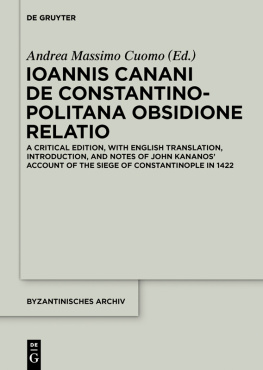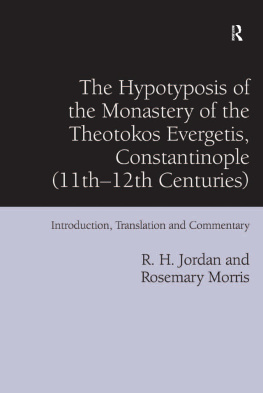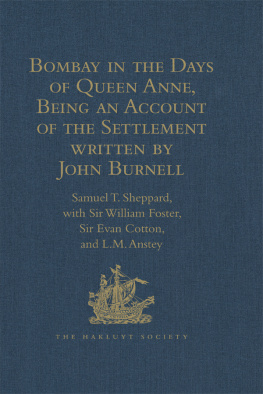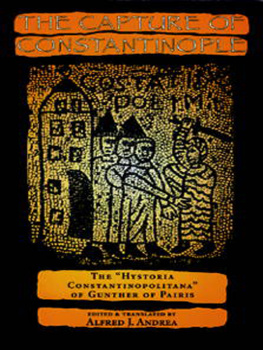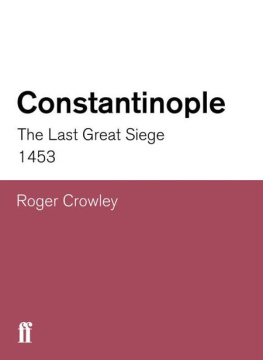Ioannis Canani de Constantinopolitana obsidione relatio
Guide

Ioannis Canani de Constantinopolitana obsidione relatio
Byzantinisches Archiv

Begrndet von Karl Krumbacher
Als Ergnzung zur Byzantinischen Zeitschrift herausgegeben von Albrecht Berger
Band 30

ISBN 978-1-5015-1090-8
e-ISBN (PDF) 978-1-5015-0288-0
e-ISBN (EPUB) 978-1-5015-0290-3
ISSN 1864-9785
Library of Congress Cataloging-in-Publication Data
A CIP catalog record for this book has been applied for at the Library of Congress.
Bibliographic information published by the Deutsche Nationalbibliothek
The Deutsche Nationalbibliothek lists this publication in the Deutsche Nationalbibliografie; detailed bibliographic data are available on the Internet at http://dnb.dnb.de.
2016 Walter de Gruyter Inc., Boston/Berlin
www.degruyter.com

This book is dedicated to Katharina
Foreword
This book contains a new critical edition of John Kananos narrative of the Ottoman siege of Constantinople in 1422. Its purpose is to give historians and curious readers a fascinating narrative, with its original character restored.
The report of Kananos and its otherwise unknown author have been objects of constant interest over the years; the brief account is, in fact, a valuable picture of the first great Turkish siege of Constantinople taken by a shrewd eye-witness.
After the editio princeps by Leon Allatios in 1651, Kananos Diegesis was included in the series Corpus Bonnense Scriptorum Historiae Byzantinae (ed. Bekker) in 1838. Maria Elisabetta Colonna dedicated two important studies to this and provided the text with the first complete translation into a modern language. Emilio Pinto then published two critical editions, very close to Bekker 1838, in 1968 and 1977 respectively.
The historically relevant details contained in the Diegesis have been subject of debate by historians and philologists such as Baynes 1949; Williams 1999; Turnbell 2004; Serrano Espinosa 2006; Harris 2007; Nicolle 2007; Shoemaker 2010; Philippides Hanak 2011. Kananos style, in turn, has been the object of acute remarks by Hunger 1978 and evenko 1981, but not systematically.
Recently, historians of the Ottoman Empire have also looked at Kananos as a relevant historical source.
An important study, which thoroughly explores the siege of 1422, is Purdie 2009, an open-access MA thesis supervised by Professor John Melville-Jones, whom I had the opportunity to meet in Perth (WA) in March 2014. Purdie 2009 offers the first complete English translation of Kananos and provides the Diegesis with an extensive historical commentary.
I have decided to design my edition to focus on three main objectives, the historical aspects concerning Kananos account having been already thoroughly investigated.
First of all, I have aimed to edit the text more faithfully to the meaning of Kananos original intent. Recent paleographical and linguistic studies endorsed a new critical edition of the Diegesis and ultimately, the style of the editions of medieval (and vernacular) texts suggest more conservative and respectful editorial principles. So this newly published Diegesis returns to the original vernacular character, as several normalizing and Atticizing lectiones , due to later copyists and previous editors, have been removed.
The second objective was to offer Kananos to the widest possible public. To this end, I made a new translation, sympathetic to the re-edited text, and I provided it with contextualizing footnotes. I also took into account Turkish sources, especially the Ottoman Anonymous Chronicles (ed. Giese 19221925; see Kastritsis 2007 and 2015) and studies, such as the above mentioned Brill Encyclopedia of Islam .
The third objective was to focus on philological and linguistic issues which, I think, have been neglected. Thus, I tried to sketch the profiles of Kananos and of his audience(s); the reasons for his stylistic choices; how he used his sources and the characteristics of his Greek. Consequently, I kept historical remarks to a minimum.
The book is structured as follows.
Part 1, Introduction. I briefly survey the historical events which led to the siege in 1422 and I contextualize the Diegesis. Here I describe the manuscripts and illustrate the paleographical evidence which required a new critical edition. Furthermore, I explain my editorial principles and how I approach texts written in a low-registered variety of Medieval Greek. A survey on Kananos language concludes this part. Highly inspiring, were the several discussions within the framework of the Viennese Forum for Sociolinguistics (www.oeaw.ac.at/sociolinguistics), of Vedi Vienna Editorial Initiative (www.oeaw.ac.at/byzanz/vedi.htm) and the meetings organized both in Nicosia and in Vienna by Antonia Giannouli.
Part 2, Critical Edition, Translation and Notes. Here I offer a text with its restored vernacular character, provided with a translation and commentaries ad locum, as I have already said.
As to the critical edition, I provided the critical text with two apparatus . First, I recorded parallel passages and probable sources of some interesting locutions employed by Kananos. Furthermore, I quoted passages from other known historical sources which also narrate the siege of Constantinople in 1422, in order to enable the reader to compare Kananos with other accounts, side by side. In the second apparatus, the criticus , I recorded all the different readings which are useful for the understanding of my editorial choices, and which illustrate the reception of the Diegesis throughout the centuries.
As far as the translation itself is concerned, I strove to be as true as possible to the original and to reproduce in modern English the colors (including unusual words, repetitions, pleonasms, variations of style, etc.) which I have identified in the Greek source. However, I had Purdie 2009 as a valuable source. I hope to have been close to the mark and beg the forgiveness of native speakers of English, who may have reached the target with greater ease, giving an artistic translation.
Part 3, Thesaurus. Here I list, translate, and analyze all the words used by Kananos. I focus on their morphology and on how they appear in the manuscripts. When registering prepositions and conjunctions, I also give examples illustrating their grammar. My Thesaurus will serve as a complement to the paragraphs of Part 1 concerning the language of Kananos.
Now, after two years of intermittent work, I would like to express my gratitude to Erich Trapp who coordinated the project, funded by the Austrian National Fund, Imitation / Innovation: The Vocabulary of Late Byzantine History Writing , within the framework of which this book has been conceived and realized. It has been a great honor to work alongside him and see him successfully concluding his Lexikon zur byzantinischen Grzitt . I am also most obliged to my colleagues in the Division of Byzantine Research (Austrian Academy of Sciences) and to its head, Claudia Rapp. They all particularly Carolina Cupane, Christian Gastgeber, Jana Gruskov, and Andreas Rhoby have supported me in every single phase of my research.

